The Obligatory
"Play safe. Ski only in clockwise direction. Let's all have fun together."
Sunday, September 24, 2006
First Night, Harajuku and the Meiji-Jingu Shrine
Tonight, the first night in Tokyo. Strangely, although I hadn’t slept at all on the plane, I was not tired, or even groggy. The airport at Narita was very clean, and extremely well organized. Going through customs was a breeze (although, apparently the prop sword I tried to send was confiscated), although not as many people in Japan speak English as they’d like you to believe.
We boarded a bus for the hotel, but unfortunately it was too dark and foggy to really see any of the countryside as we drove into Tokyo. Kevin, Jim, Olivia and I all used the power of our wireless DS’es to pass the time with a few games of Tetris, but otherwise that was it. The bus was silent. No one was talking on their cell phones, very few people were talking to each other. The place was like a mobile library.
When we got to the hotel, I went straight up to my room to drop off my baggage and wash my face. Which is when I noticed, for the first time, that my eyes were almost completely bloodshot red. I guess people were too polite to tell me. And I also guess that my eyes are really, really sensitive to dry air.
The very first thing I did in my hotel room, though, was head straight for the bathroom. I wanted to use a bidet for a sight gag in one of the skits I’m shooting here, and had to make sure the things worked without someone actually sitting down … and that I had the mechanical skills necessary to figure out how the things worked, period.
Ours had a weight sensor on the toilet, so I tried pressing down on the rim with my hands, then hitting the bidet button. A loud mechanical whirr filled the bathroom, and a small q-tip sized object emerged from the bowl. It dripped water, then shot it into the bowl beneath it. I figured that was it. The machine stopped making noises. Then it shot warm water directly in my face. I put my hands up to block it, and the thing kept spraying.
Comedy accomplished.
I’d figured out how to use the bidet when I’m not supposed to, but I’d also soaked my shirt with toilet water. Small price to pay.
I changed my shirt and headed downstairs to meet up with some of the other crew here with AOTS. We had a few drinks at the bar, then a group of us splintered off to wander into Shinjuku for a bite to eat.
We stopped in a hole-in-the-wall Japanese barbeque-type place. No one spoke English, and we only spoke a very tiny amount of Japanese, so ordering was interesting. There was a lot of pointing, nodding, smiling and hand gesturing, and I was struck with how incredibly patient our servers were. Try to imagine a large group of foreigners walking into your favorite restaurant and not being able to speak any English. The American wait-staff aren’t very tolerant in that vision, are they?
There was very little on the menu that was lacto-ovo-pesca-vegetarian friendly, surprisingly. But I did find a small vegetarian selection, and tried out some roasted ginko nuts, which came on a small skewer. Eight small nuts was all the food I got for about $6.50 American, but I wasn’t too hungry anyway, and the sake more than made up for it.
Afterward, a few stayed around Shinjuku to explore, but I was having trouble keeping my eyelids elevated, so I trekked back to the hotel and promptly passed out.

Friday morning, I woke up early and met up with Kevin and Luis do a bit of exploring. This was one of the very few days that everyone on the crew had off, and we wanted to make sure we took advantage of it.
Kevin acted as our guide through the Japan Rail Shinjuku station that’s right next to our hotel, showing us exactly how to read the maps, not get screwed by the automated ticket machines, and how to walk through the gates without getting a door slammed in your crotch. Although everything’s in Japanese, obviously, there are a few English-language prompts that were helpful. And even though the subway map here is unbelievably complicated-looking, it’s pretty intuitive if you’ve ever ridden mass transit before.

The one thing that is unusual, though, is that there are several different companies that operate the railways. A ticket bought for one line won’t necessarily get you to another station if you have to make a transfer. Which is pretty weird. Every other city I’ve been to that has a subway system owns everything. But hey, what are you gonna do?
We rode to Shibuya and walked around the hip, upscale shopping areas before ducking into the maze of unmarked back-alleys that makes up most of the city of Tokyo. Kevin had eaten at a great ramen place the last time he was out here, and wanted to share.
Oddly, walking through this giant shopping district was easy. No one was around. It was a bit after nine, approaching ten ‘o clock. And yet, very few businesses were open at all. And everywhere we looked, no one was serving anything that would remotely resemble breakfast food.
While I’m a big fan of the good ol’ fashioned Western breakfast, while in Japan, I did want to try the local version. Unfortunately, this was extremely difficult. Not only because nothing seemed to be open before 11AM, but also because almost everything had pork or beef in it. Everything. I figured I’d have an easy time finding vegetarian or fish-based food here, but it’s actually a lot more difficult than you’d think. It was definitely more difficult than I thought.
The ramen place we were aiming at didn’t open for another hour, and it looked like there were big ol’ slabs of pig in every bowl. So, still hungry, we got back on the rail and went to Harajuku instead.
Right off the train station, we spotted a waffle house café, serving both coffee AND semi-Western breakfast foods. Fantastic! We went inside, awkwardly pointed to the items we wanted, and ate. I got a green tea waffle with vanilla ice cream, red bean paste, and green tea syrup, along with a cup of black coffee. And it was delicious.
One thing we’ve all noticed here is that, while Japan does have some of the same foods as Americans do, they ALL come in much, much smaller portions. The coffee I got at this café would have barely filled a dainty teacup stateside. And it wasn’t cheap, either. Likewise, the two waffles I ate put together would barely top the size of a single Eggo. At the Starbucks Luis and I stopped in during a moment of weakness, five bucks gets you a Venti coffee that’s about the size of an American medium. Rarely have I felt like such a food-guzzler as I do here.
But anyway, back to Harajuku. Harajuku’s the district that’s where most of the weird Japanese fashion we see comes from. Now, I probably go out to buy new clothes once, maybe twice a year. But walking down the narrow streets, lined with shoe stores and t-shirt boutiques, I actually wanted to spend money on clothes. There’s so much there that’s just so Japanese that you’d never be able to find in the States. And the prices weren’t too bad, either. Except in some of the ritzier boutiques. The Bathing Ape was particularly egregious, charging about $70 for a plain t-shirt, up to over $1000 for a one-off bedazzled shirt that just read “BAPE.” It’s all about presentation, though. As Kevin noted, if you display your product as art, then you can sell it at gallery prices. Even if it’s just a baseball cap.
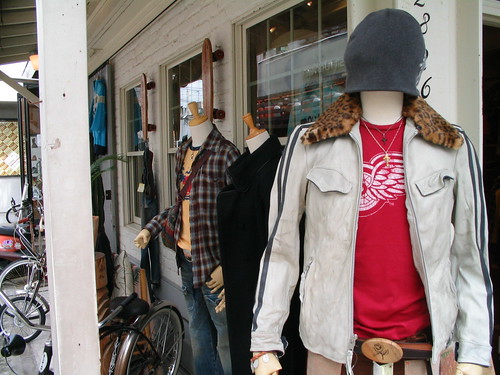
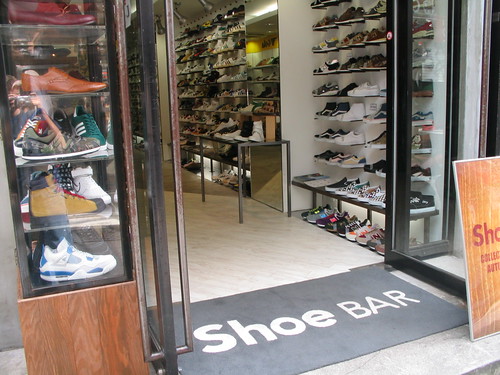
Not to be labeled as just another clothing district, the neighborhood also has a ton of really interesting and intricate street art. A little somethin' for everybody.
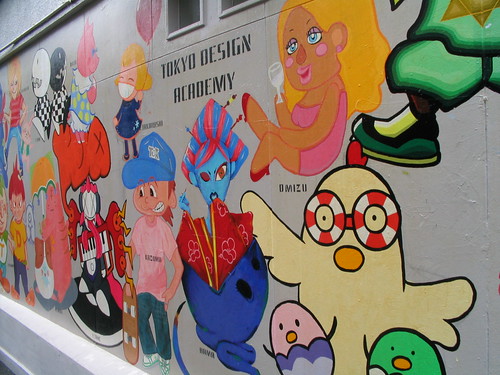


We also stopped off in a 7-story toy store, where EVERYTHING WAS ADORABLE. No other way to describe it.
To counter all this rampant consumerism, we took a walk to the Meiji shrine and park near Harajuku Station. While it directly borders the trendy shopping district, it is a world apart. A dense wooded forest, filled with stone footpaths and bubbling streams that run beneath arched bridges, here the sound of crows, crickets, and other birds completely drowned out the noise of the megalopolis that surrounded us.
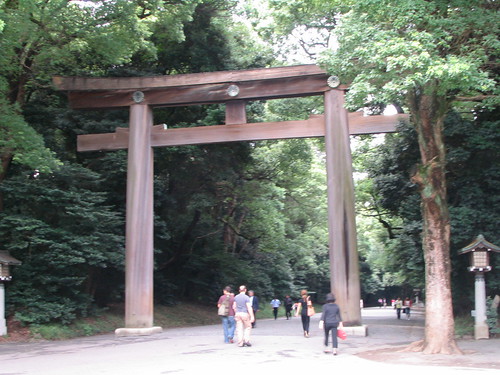
We took a very slow walk through some of the giant Dorii gates and into Emperor Meiji’s old garden, which was very tranquil. Even the koi pond, stocked with giant goldfish that bobbed at the surface whenever they sensed a human standing nearby. Further in, we made it to Emperor Meiji’s official shrine, which was incredibly peaceful.
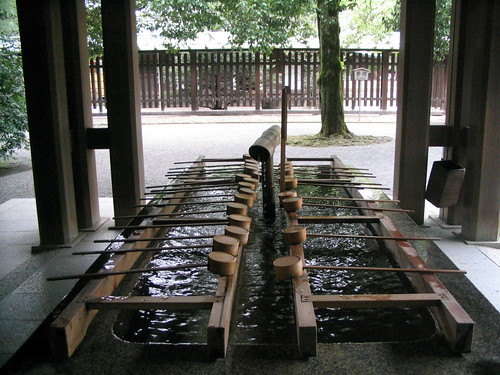
We all performed a cleansing ritual before we entered, using local spring water to wash our hands and mouths. We all bought a prayer sign to hang on one of the trees inside, and walked into the actual shrine itself, where people lined up to pray, stopping to bow twice and clap their hands.
This experience, in particular, highlighted for me just how dualistic the Japanese nation is. We’d just walked from a high-tech, ultra-modern fashion center, where everyone was encouraged to consume and buy everything in sight into a dense, forested center of one of the world’s oldest religions. Old and new co-existing relatively peacefully together. Young and old, both buying the newest cell phones and praying to a deified emperor. That’s really one of the lessons we can learn from Japan – you don’t necessarily need to completely disown the traditions of the past in order to move into the future.
Also, I think our society would benefit from having some Japanese-style vending machines around. You can get ANYTHING from those things!

That night, we went out to a more large scale version of the barbeque-style restaurant we ate at the night before. Except instead of being in a basement, it was on top of a building in the Shibuya district. In a nice touch of aesthetics, the glass elevator we rode to the top started dimming its lights as we rose above the roofline, allowing the illuminated city to appear before us, spreading out in every conceivable direction. And since there’s no grid system in Tokyo, there’s no way to put scale or order on the sprawl. When someone asks how you can possibly feel claustrophobic in an open city, bring ‘em to Tokyo.
The gray concrete and glass exterior of the building stood in stark contrast to the décor inside the restaurant, which was all open ceilings, wood beams, and traditional paper door rooms. Luckily, there were slightly more vegetarian options on this menu … I had an order of lotus stalks, coated in oil, soy sauce, and sugar – not as sweet as they sound, but very good and crunchy, like a tastier celery; seared ahi skewers with tartar sauce; and a bowl of pickled onion rice, which was quite pungent and reminded me a lot of sauerkraut. And, of course, some beer and sake to round everything out.
After stumbling to the Shibuya train station, I got back to the hotel and immediately collapsed in bed.
More pictures on Flickr, and more to come when I get a bit more settled in back in the States.
We boarded a bus for the hotel, but unfortunately it was too dark and foggy to really see any of the countryside as we drove into Tokyo. Kevin, Jim, Olivia and I all used the power of our wireless DS’es to pass the time with a few games of Tetris, but otherwise that was it. The bus was silent. No one was talking on their cell phones, very few people were talking to each other. The place was like a mobile library.
When we got to the hotel, I went straight up to my room to drop off my baggage and wash my face. Which is when I noticed, for the first time, that my eyes were almost completely bloodshot red. I guess people were too polite to tell me. And I also guess that my eyes are really, really sensitive to dry air.
The very first thing I did in my hotel room, though, was head straight for the bathroom. I wanted to use a bidet for a sight gag in one of the skits I’m shooting here, and had to make sure the things worked without someone actually sitting down … and that I had the mechanical skills necessary to figure out how the things worked, period.
Ours had a weight sensor on the toilet, so I tried pressing down on the rim with my hands, then hitting the bidet button. A loud mechanical whirr filled the bathroom, and a small q-tip sized object emerged from the bowl. It dripped water, then shot it into the bowl beneath it. I figured that was it. The machine stopped making noises. Then it shot warm water directly in my face. I put my hands up to block it, and the thing kept spraying.
Comedy accomplished.
I’d figured out how to use the bidet when I’m not supposed to, but I’d also soaked my shirt with toilet water. Small price to pay.
I changed my shirt and headed downstairs to meet up with some of the other crew here with AOTS. We had a few drinks at the bar, then a group of us splintered off to wander into Shinjuku for a bite to eat.
We stopped in a hole-in-the-wall Japanese barbeque-type place. No one spoke English, and we only spoke a very tiny amount of Japanese, so ordering was interesting. There was a lot of pointing, nodding, smiling and hand gesturing, and I was struck with how incredibly patient our servers were. Try to imagine a large group of foreigners walking into your favorite restaurant and not being able to speak any English. The American wait-staff aren’t very tolerant in that vision, are they?
There was very little on the menu that was lacto-ovo-pesca-vegetarian friendly, surprisingly. But I did find a small vegetarian selection, and tried out some roasted ginko nuts, which came on a small skewer. Eight small nuts was all the food I got for about $6.50 American, but I wasn’t too hungry anyway, and the sake more than made up for it.
Afterward, a few stayed around Shinjuku to explore, but I was having trouble keeping my eyelids elevated, so I trekked back to the hotel and promptly passed out.

Friday morning, I woke up early and met up with Kevin and Luis do a bit of exploring. This was one of the very few days that everyone on the crew had off, and we wanted to make sure we took advantage of it.
Kevin acted as our guide through the Japan Rail Shinjuku station that’s right next to our hotel, showing us exactly how to read the maps, not get screwed by the automated ticket machines, and how to walk through the gates without getting a door slammed in your crotch. Although everything’s in Japanese, obviously, there are a few English-language prompts that were helpful. And even though the subway map here is unbelievably complicated-looking, it’s pretty intuitive if you’ve ever ridden mass transit before.

The one thing that is unusual, though, is that there are several different companies that operate the railways. A ticket bought for one line won’t necessarily get you to another station if you have to make a transfer. Which is pretty weird. Every other city I’ve been to that has a subway system owns everything. But hey, what are you gonna do?
We rode to Shibuya and walked around the hip, upscale shopping areas before ducking into the maze of unmarked back-alleys that makes up most of the city of Tokyo. Kevin had eaten at a great ramen place the last time he was out here, and wanted to share.
Oddly, walking through this giant shopping district was easy. No one was around. It was a bit after nine, approaching ten ‘o clock. And yet, very few businesses were open at all. And everywhere we looked, no one was serving anything that would remotely resemble breakfast food.
While I’m a big fan of the good ol’ fashioned Western breakfast, while in Japan, I did want to try the local version. Unfortunately, this was extremely difficult. Not only because nothing seemed to be open before 11AM, but also because almost everything had pork or beef in it. Everything. I figured I’d have an easy time finding vegetarian or fish-based food here, but it’s actually a lot more difficult than you’d think. It was definitely more difficult than I thought.
The ramen place we were aiming at didn’t open for another hour, and it looked like there were big ol’ slabs of pig in every bowl. So, still hungry, we got back on the rail and went to Harajuku instead.
Right off the train station, we spotted a waffle house café, serving both coffee AND semi-Western breakfast foods. Fantastic! We went inside, awkwardly pointed to the items we wanted, and ate. I got a green tea waffle with vanilla ice cream, red bean paste, and green tea syrup, along with a cup of black coffee. And it was delicious.
One thing we’ve all noticed here is that, while Japan does have some of the same foods as Americans do, they ALL come in much, much smaller portions. The coffee I got at this café would have barely filled a dainty teacup stateside. And it wasn’t cheap, either. Likewise, the two waffles I ate put together would barely top the size of a single Eggo. At the Starbucks Luis and I stopped in during a moment of weakness, five bucks gets you a Venti coffee that’s about the size of an American medium. Rarely have I felt like such a food-guzzler as I do here.
But anyway, back to Harajuku. Harajuku’s the district that’s where most of the weird Japanese fashion we see comes from. Now, I probably go out to buy new clothes once, maybe twice a year. But walking down the narrow streets, lined with shoe stores and t-shirt boutiques, I actually wanted to spend money on clothes. There’s so much there that’s just so Japanese that you’d never be able to find in the States. And the prices weren’t too bad, either. Except in some of the ritzier boutiques. The Bathing Ape was particularly egregious, charging about $70 for a plain t-shirt, up to over $1000 for a one-off bedazzled shirt that just read “BAPE.” It’s all about presentation, though. As Kevin noted, if you display your product as art, then you can sell it at gallery prices. Even if it’s just a baseball cap.


Not to be labeled as just another clothing district, the neighborhood also has a ton of really interesting and intricate street art. A little somethin' for everybody.



We also stopped off in a 7-story toy store, where EVERYTHING WAS ADORABLE. No other way to describe it.
To counter all this rampant consumerism, we took a walk to the Meiji shrine and park near Harajuku Station. While it directly borders the trendy shopping district, it is a world apart. A dense wooded forest, filled with stone footpaths and bubbling streams that run beneath arched bridges, here the sound of crows, crickets, and other birds completely drowned out the noise of the megalopolis that surrounded us.

We took a very slow walk through some of the giant Dorii gates and into Emperor Meiji’s old garden, which was very tranquil. Even the koi pond, stocked with giant goldfish that bobbed at the surface whenever they sensed a human standing nearby. Further in, we made it to Emperor Meiji’s official shrine, which was incredibly peaceful.

We all performed a cleansing ritual before we entered, using local spring water to wash our hands and mouths. We all bought a prayer sign to hang on one of the trees inside, and walked into the actual shrine itself, where people lined up to pray, stopping to bow twice and clap their hands.
This experience, in particular, highlighted for me just how dualistic the Japanese nation is. We’d just walked from a high-tech, ultra-modern fashion center, where everyone was encouraged to consume and buy everything in sight into a dense, forested center of one of the world’s oldest religions. Old and new co-existing relatively peacefully together. Young and old, both buying the newest cell phones and praying to a deified emperor. That’s really one of the lessons we can learn from Japan – you don’t necessarily need to completely disown the traditions of the past in order to move into the future.
Also, I think our society would benefit from having some Japanese-style vending machines around. You can get ANYTHING from those things!

That night, we went out to a more large scale version of the barbeque-style restaurant we ate at the night before. Except instead of being in a basement, it was on top of a building in the Shibuya district. In a nice touch of aesthetics, the glass elevator we rode to the top started dimming its lights as we rose above the roofline, allowing the illuminated city to appear before us, spreading out in every conceivable direction. And since there’s no grid system in Tokyo, there’s no way to put scale or order on the sprawl. When someone asks how you can possibly feel claustrophobic in an open city, bring ‘em to Tokyo.
The gray concrete and glass exterior of the building stood in stark contrast to the décor inside the restaurant, which was all open ceilings, wood beams, and traditional paper door rooms. Luckily, there were slightly more vegetarian options on this menu … I had an order of lotus stalks, coated in oil, soy sauce, and sugar – not as sweet as they sound, but very good and crunchy, like a tastier celery; seared ahi skewers with tartar sauce; and a bowl of pickled onion rice, which was quite pungent and reminded me a lot of sauerkraut. And, of course, some beer and sake to round everything out.
After stumbling to the Shibuya train station, I got back to the hotel and immediately collapsed in bed.
More pictures on Flickr, and more to come when I get a bit more settled in back in the States.
Labels: travel
1 Comments:
Next year maybe you can get someone to moisten your eyes....
pick me.
Seriously, I hate like flag squad hates cheerleaders. going to look at flickr pictures nows
pick me.
Seriously, I hate like flag squad hates cheerleaders. going to look at flickr pictures nows
, at 10:42 PM















